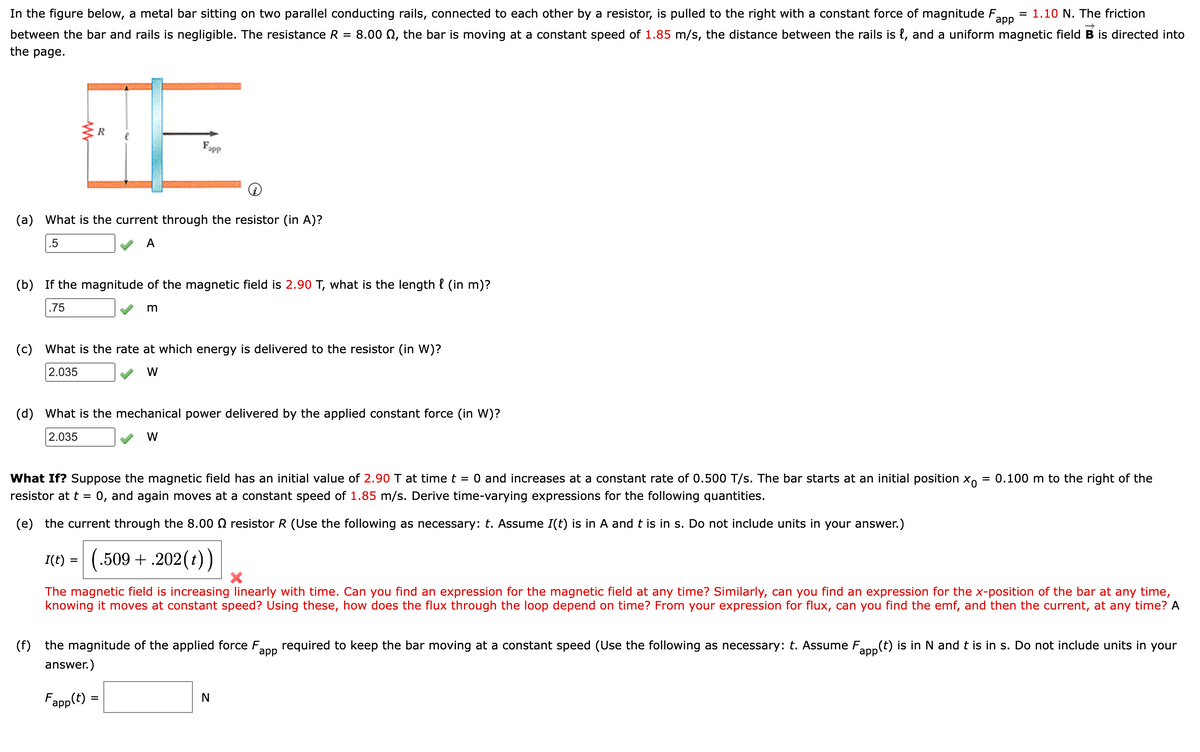In the figure below, a metal bar sitting on two parallel conducting rails, connected to each other by a resistor, is pulled to the right with a constant force of magnitude Fano = 1.10 N. The friction between the bar and rails is negligible. The resistance R = 8.00 Q, the bar is moving at a constant speed of 1.85 m/s, the distance between the rails is {, and a uniform magnetic field B is directed into the page. (a) What is the current through the resistor (in A)? .5 (b) If the magnitude of the magnetic field is 2.90 T, what is the length { (in m)? .75 m (c) What is the rate at which energy is delivered to the resistor (in W)? 2.035 w
In the figure below, a metal bar sitting on two parallel conducting rails, connected to each other by a resistor, is pulled to the right with a constant force of magnitude Fano = 1.10 N. The friction between the bar and rails is negligible. The resistance R = 8.00 Q, the bar is moving at a constant speed of 1.85 m/s, the distance between the rails is {, and a uniform magnetic field B is directed into the page. (a) What is the current through the resistor (in A)? .5 (b) If the magnitude of the magnetic field is 2.90 T, what is the length { (in m)? .75 m (c) What is the rate at which energy is delivered to the resistor (in W)? 2.035 w
Physics for Scientists and Engineers: Foundations and Connections
1st Edition
ISBN:9781133939146
Author:Katz, Debora M.
Publisher:Katz, Debora M.
Chapter32: Faraday’s Law Of Induction
Section: Chapter Questions
Problem 71PQ: Two frictionless conducting rails separated by l = 55.0 cm are connected through a 2.00- resistor,...
Related questions
Question

Transcribed Image Text:In the figure below, a metal bar sitting on two parallel conducting rails, connected to each other by a resistor, is pulled to the right with a constant force of magnitude F,
app
= 1.10 N. The friction
between the bar and rails is negligible. The resistance R
8.00 Q, the bar is moving at a constant speed of 1.85 m/s, the distance between the rails is {, and a uniform magnetic field B is directed into
%D
the page.
R
Fapp
(a) What is the current through the resistor (in A)?
.5
A
(b) If the magnitude of the magnetic field is 2.90 T, what is the length e (in m)?
.75
m
(c) What is the rate at which energy is delivered to the resistor (in W)?
2.035
W
(d) What is the mechanical power delivered by the applied constant force (in W)?
2.035
W
What If? Suppose the magnetic field has an initial value of 2.90 I at time t = 0 and increases at a constant rate of 0.500 T/s. The bar starts at an initial position x.
resistor at t = 0, and again moves at a constant speed of 1.85 m/s. Derive time-varying expressions for the following quantities.
= 0.100 m to the right of the
(e) the current through the 8.00 N resistor R (Use the following as necessary: t. Assume I(t) is in A and t is in s. Do not include units in your answer.)
I(t) =
|(.509 + .202(1))
The magnetic field is increasing linearly with time. Can you find an expression for the magnetic field at any time? Similarly, can you find an expression for the x-position of the bar at any time,
knowing it moves at constant speed? Using these, how does the flux through the loop depend on time? From your expression for flux, can you find the emf, and then the current, at any time? A
(f) the magnitude of the applied force F
app
required to keep the bar moving at a constant speed (Use the following as necessary: t. Assume Fanp(t) is in N and t is in s. Do not include units in your
app
answer.)
Fapp(t) =
Expert Solution
This question has been solved!
Explore an expertly crafted, step-by-step solution for a thorough understanding of key concepts.
Step by step
Solved in 3 steps with 3 images

Knowledge Booster
Learn more about
Need a deep-dive on the concept behind this application? Look no further. Learn more about this topic, physics and related others by exploring similar questions and additional content below.Recommended textbooks for you

Physics for Scientists and Engineers: Foundations…
Physics
ISBN:
9781133939146
Author:
Katz, Debora M.
Publisher:
Cengage Learning

Physics for Scientists and Engineers
Physics
ISBN:
9781337553278
Author:
Raymond A. Serway, John W. Jewett
Publisher:
Cengage Learning

Physics for Scientists and Engineers with Modern …
Physics
ISBN:
9781337553292
Author:
Raymond A. Serway, John W. Jewett
Publisher:
Cengage Learning

Physics for Scientists and Engineers: Foundations…
Physics
ISBN:
9781133939146
Author:
Katz, Debora M.
Publisher:
Cengage Learning

Physics for Scientists and Engineers
Physics
ISBN:
9781337553278
Author:
Raymond A. Serway, John W. Jewett
Publisher:
Cengage Learning

Physics for Scientists and Engineers with Modern …
Physics
ISBN:
9781337553292
Author:
Raymond A. Serway, John W. Jewett
Publisher:
Cengage Learning

Principles of Physics: A Calculus-Based Text
Physics
ISBN:
9781133104261
Author:
Raymond A. Serway, John W. Jewett
Publisher:
Cengage Learning


College Physics
Physics
ISBN:
9781285737027
Author:
Raymond A. Serway, Chris Vuille
Publisher:
Cengage Learning